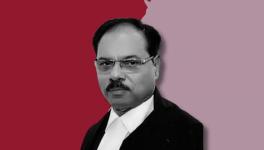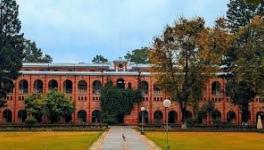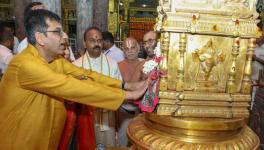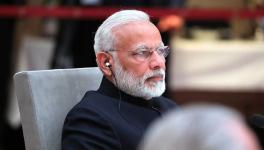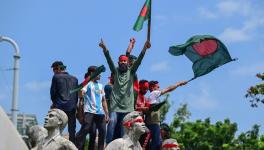Art World Remembers M F Husain 10 Years After the Artist Died in Forced Exile
New Delhi: Ten years after he died in London, yearning to return home but unable to because of death threats against him, Maqbool Fida Husain remains one of India’s most important and sought after artists whose oeuvre inspires art and conversations across the globe.
An avid reader of history and mythology and Indian culture, a large part of Husain’s art includes paintings of gods and goddesses in the context of the politics of the time, works that put him in the crosshairs of controversy.
With FIRs and persistent death threats, Husain was forced into self-exile, staying in Dubai and travelling to New York and London, where he died on June 9, 2011 at the age of 95, leaving behind a prodigious body of work. A year before that, he had taken citizenship of Qatar and those close to him remember his desperation to return to his own country, even if it was for half an hour for a cup of chai.
Pluralistic and political, he was the celebrity who began life painting cinema hoardings and remained always approachable, restless and yet dogged in the perseverance of his art.
Curator Kishore Singh remembered the artist as exceptionally accessible.
Recalling the period before the Asian Games of 1982 when Husain was painting murals for the ceiling of the Kanishka Hotel in New Delhi (now known as the Shangri La), the DAG curatorial director says he would often stop by for a chat and a cup of chai.
“I was a frequent visitor at the hotel, then under construction, and it was fascinating to see him scramble nimbly up the scaffolding to supervise the work.
“One could casually walk across to him to say hello, share a cup of tea, chat—things that would have been difficult in today’s culture of celebrity. He was approachable and accessible,” Singh told PTI.
Pluralistic and political, Husain was a striking figure with his silver mane and beard. India’s “barefoot Picasso” as he was once called was refused entry to a South Mumbai club because he wouldn’t wear shoes. The only thing predictable about his personality was in fact his unpredictability.
His was a larger than life personality whose zeal and resilience came across in his bright palette, strong lines and of course his brawny horses. He also had a keen interest in public personalities, be it Indira Gandhi, Mother Teresa, or Madhuri Dixit. The deep suffering of rural India was another recurrent theme of his paintings.
The artist extraordinaire, experts recall, was as capable of creating works for an entire solo show in less than a week’s time, as he was of turning up two hours late at his own live painting event. He was also the person asking to get a table booked at his favourite restaurant the day before he passed away.
Part of the Progressive Arts Movement, he was, as gallerist Uma Jain puts it, “a common man’s artist”.
“Husain sahib is a name synonymous with modern Indian art. While artists like (F N) Souza and (S H) Raza, and (V S) Gaitonde have made significant contributions to popularising Indian art among connoisseurs, for the common man it was always M F Husain,” said the owner of Delhi’s Dhoomimal gallery.
One factor for Husain’s immense popularity was his ease in public places that allowed people the liberty to watch an artist of his stature work.
Vadehra Gallery’s Arun Vadehra, who knew Husain and worked closely with him for over 20 years, said the artist never had a studio of his own in his nearly eight-decade career.
“Wherever he went…wherever he parked himself that became his studio,” Vadehra said, adding that his Defence Colony gallery had often served as a studio for Husain, where he created at least 500 works.
Cultural theorist and curator Ranjit Hoskote remembered a chance encounter with the artist at Mumbai’s Pundole Art Gallery.
“It was amazing to see how he would sit absolutely quiet for half an hour, sipping his pudina chai, and then spring into action, calling for a brush, paint and paper, which were always kept ready for him.
“Over the next half hour, he would produce image after image, his gestures smooth, steady, unwavering, as he translated what he had been visualising in his mind into his distinctive pictorial language. It was an extraordinary privilege to observe an artist of his stature in action like this, like a dancer in the balletic grace of his movements,” Hoskote said.
Husain was best known for his horses. Majestic and stately in all their might, they have occupied the walls of several well-known spaces across the globe, including the Asia Society Museum in New York.
But he was much more than just a painter of horses.
“His stellar works include series based on the Ramayana and the Mahabharata. He ‘iconicised’ the rivers Ganga and Jamuna in the form of goddesses, and painted Mother Teresa. He mocked the Raj intelligently through a series of paintings, and painted the story of Indian civilisation through its culture and sacred philosophy,” Singh said.
Almost all of Husain’s works were born out of his deep love for his country.
Be it the “Between the Lamp and the Spider” symbolic of the pluralistic culture of India that literary-cultural critic Ashok Vajpeyi said he truly cherishes, or the series on 'Arab Civilisation' he made in Qatar in the last years of his life, each of his works had his love for the motherland at the core of it.
It was one such painting —“Bharat Mata” – in which he painted a nude Mother India, a personification of the country, that forced him into exile in 2006.
Discussing the boldness of Husain’s artistic practice and how he would have fared in present day India, Vajpeyi said, “He would have been haunted by Hindutva forces and drawn to courts, despite the fact that in the entire Indian history, he is the only artist, till date, who has painted in more than a hundred canvases, the Ramayans and the Mahabharata.”
Hoskote agreed.
“Husain, a deeply pluralist figure, was falsely accused of insulting beliefs for which he, in fact, had the highest regard. The images for which he was pilloried had been shown, decades before, in the context of popular Ramayana jatras organised under the aegis of the thinker and political figure Ram Manohar Lohia.
“Husain had studied the Ramayana carefully with pandits arranged for him by his friend and patron Badri Vishal Pittie. All this has been forgotten, and vile calumny has been visited upon Husain. Unfortunately, it is these toxic, regressive forces that are in the ascendant in India today,” he says.
During his Progressive Art Movement days, there were times Husain sold paintings for Rs 10. In 2020, nine years after his death, his work "Voices" (1958) fetched Rs 18.47 crore, becoming the most expensive artwork by the artist.
Get the latest reports & analysis with people's perspective on Protests, movements & deep analytical videos, discussions of the current affairs in your Telegram app. Subscribe to NewsClick's Telegram channel & get Real-Time updates on stories, as they get published on our website.










